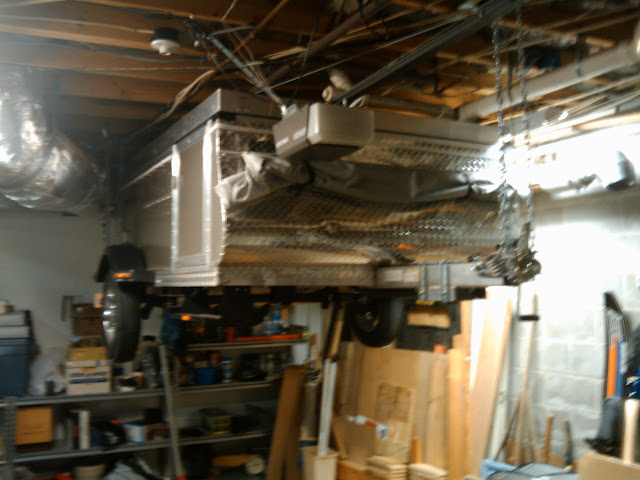There's not too much that you can do. Rubber just deteriorates. Keeping the tires out of sunlight and in moderate temperatures will help, but you still need to replace them every 3 to 5 years. The older they get, the more likely they are to have tread separations and other symptoms of structural failure.
I'm not sure about Armorall, but I suspect that it's primarily cosmetic. The natural deterioration of tires doesn't necessarily start on the outside surfaces. Tread separations can begin in the middle of the tread structure, in areas that Armorall can't be applied to.
I'm replacing my tires after 10 years. I bought new ones last year but I'm just getting around to installing them.
I've been told to not park them on dirt/grass for long periods of time (moisture isn't good) and cover the sides when parking for long periods of time to protect from the sun drying them out.
Old tire tread and side wall rot:
[smg id=323][smg id=321]
New tire tread and load rating: Load Range D - 1660 lbs
[smg id=319][smg id=320]
Back in the early 90's, I worked for a local family owned tire store. While I was there, the warehouse manager found some wide white wall tires that had been in the warehouse for about 6 years. The tires had been dry and out of the sun. They decided to sell them (very cheap) for trailer queen collector car use with lots of warnings and disclosures. These tires looked great, but one customer that decided to drive on them to and from local cruise-in car shows came back very soon to replace one tire that developed a tread separation.
The point of all of this is that an old tire that looks great can have significant deterioration inside the tire where you can't see it. The "cover" doesn't tell the whole story.
Armorall is primarily liquid silicone; and it is the silicone that keeps the rubber supple ... at least on the outside. I've used it or simular kinds of products for years and if nothing more it sure do make the tire look better! Tires, under the best of conditions, can only last so long. Have a long time fishing buddy whose SIL is a general manager of large distributor in this area and I've gotten some good inside information about tire manufacturing, warranties and just good tire information in general. With the camper tires, like already posted, keep them off the bare ground for long term storage, more important then covering them from the sun.
Back when I was really going places and doing lots of road miles, I replaced the tires every year (they were the 5.30 X 12 LRC bias tires) - their mile life was not all that great anyway. Plus, at the time, they were cheap, thirty bucks would get a new one mounted and out the door. For that kind of cost, an easy decision. But as I traveled less (higher gas prices) and tire prices went higher (at least the quality ones), replaced them now every three to five years, depending on the wear.
Yes, the unused spare tire will deteriorate despite no use, but I don't rotate them. All of the tires will be replaced due to age before tread wear, so it really doesn't matter. The spare tire justifies itself by being there in case I need it, not be getting used. If all goes well, the spare will never touch the ground.
For entertainment value...
I store my camper hanging from the ceiling in my basement and park my TV under it. (No, I'm not kidding.) So, the tires get no UV exposure, temperature extremes, contact with the ground, or anything except when we are traveling. Pretty much optimal camper and tire storage when the camper is light enough to get away with it. Axle service is real easy too. 😉
[quote author=S_Sanders link=topic=873.msg6840#msg6840 date=1308709151]
For entertainment value...
I store my camper hanging from the ceiling in my basement and park my TV under it. (No, I'm not kidding.) So, the tires get no UV exposure, temperature extremes, contact with the ground, or anything except when we are traveling. Pretty much optimal camper and tire storage when the camper is light enough to get away with it. Axle service is real easy too. 😉
Would love to see a pic of the set up...got any?
AD
[quote author=S_Sanders link=topic=873.msg6840#msg6840 date=1308709151]
For entertainment value...
I store my camper hanging from the ceiling in my basement and park my TV under it. (No, I'm not kidding.) So, the tires get no UV exposure, temperature extremes, contact with the ground, or anything except when we are traveling. Pretty much optimal camper and tire storage when the camper is light enough to get away with it. Axle service is real easy too. 😉
I think I've seen pictures of it. Is it a gray one with a red car below it? Are you on the Livin Lite Yahoo Group? I think that's where I saw it. My screen name there is 'trwei396' and I have some pics of my blue 8.1 there.
AD, It's not a great picture. It's a little out of focus, but it gets the idea across.
Tonyride, Yes, I'm the same person. How many people do you think are crazy enough to do this??? The red car was a Honda Fit that I replaced with the Golf TDI that is my current TV and commuter vehicle. I actually pulled the camper to Gatlinburg, TN with the Fit once. It did OK, but I wouldn't recommend it as a tow vehicle.
Yes, the camper is hanging in the right rear corner of a drive in basement garage parking space. I push the camper into the basement, use a hoist system that I built to lift it up. Swing three chain loops under the lift points and let the camper down to hang on the chains. Then the car is pulled in under the camper. When the front right corner of the camper body is over the left rear corner of the sunroof opening, I know I'm parked in the right place. The camper tires are too low to clear the roof of the car, so I can't back in, but there's plenty of room for the tires over the hood. The bottom of the camper step's framework is 4.5 inches above the sunroof when the car is parked under it.
I don't recall exactly when I built the lift system, but it's been about two years now. If we aren't using the camper, it is hanging in the basement. It's been up there so much now, it almost seems normal.
769
89
1 Guest(s)



